Mental
Built to ease pressure on the first Middlesex County Asylum at Hanwell, which was severely overcrowded, the second pauper asylum for Middlesex opened in 1851 at Colney Hatch. It had 1250 beds and was the largest and most modern asylum in Europe. The intention was that the Hanwell Asylum would take patients from west London and the Colney Hatch Asylum those from east London. (However, this proved administratively impossible as no-one had devised a scheme as to how east London patients already in Hanwell could be transferred to Colney Hatch. Hanwell remained overcrowded.)
The 119 acre site had been chosen because the Great Northern Railway was being constructed to pass alongside it (similarly, the Hanwell Asylum had been built beside the Grand Junction Canal, so that bulk supplies such as coal could easily be brought in).
The foundation stone was laid by the Prince Consort in 1849 and the building was completed in the record time of 19 months on November 1850. Even while it was under construction, it had been enlarged to accommodate 1250 patients instead of the originally planned 1000. Furnishing and staffing of the Asylum took a further six months.
The original cost of the Italianate-style building, with its ventilation towers and central cupola, had been established at £150,000, but the true cost proved to be double that - £300,000. At £240 per bed it was the most expensive asylum ever built. It was also the longest - 1884 feet (about 600 metres) - as the Commissioners in Lunacy wished that it be no more than two storeys high (although the sloping nature of the site meant that the wings were three storeys high). Within the buildings were six miles of corridors. The estate had its own water supply and it own farm of 75 acres, on which many of the patients were employed. It also had its own cemetery (which was in use until 1873) and a chapel.
By 1856 the Colney Hatch Lunatic Asylum had 1500 inhabitants, who were producing 100,000 gallons of sewage daily, which was distributed over 120 acres of garden and farmland. The untreated sewage flowed into Pymmes Brook and ended up in Southgate. Following complaints from the local residents the Asylum was forced to install proper sewage works.
In 1857 further extensions were built, by which time the Asylum held 2000 inmates. Serious defects of construction became apparent in 1858. In one ward the walls and rafters separated and the roof cracked; the arched ceiling gave way. In another ward part of the ceiling collapsed. It was found that the roof was generally faulty and that the foundations were insecure as only 2 feet of concrete had been used instead of the specified 4 feet. All the brick arches had to be removed and replaced by lath and plaster, and the ceilings reinforced by girders.
The Asylum was enlarged again during the years of 1875 to 1879. By 1880 conditions were very poor and the staff struggling to cope with so many patients. In 1896, when there were 2584 inmates, a temporary building made of wood and iron was erected to house 320 chronic and infirm female patients in five dormitories, even though the Commissioners in Lunacy warned that it was a serious fire risk.
In 1899 control of the Asylum passed from the Middlesex Justices of the Peace to the newly formed LCC (even though geographically the Asylum was in Middlesex). Over the years more land had been acquired - Lowen's Farm and Hollick Wood - and the original grounds expanded from 118 to 138 acres.
In 1903 the temporary wooden block built in 1896 burned down. Fifty one people died in what would be called the worst disaster in English asylum history.
Between 1908 and 1913 seven new permanent brick villas were built. One was designated for subnormal boys with epilepsy or disturbed behaviour, two with verandahs for patients with TB or dysentery, and the other four for the surviving female inmates of the fire. In 1912 a disused carpenters' shop and stores by the railway siding were converted into accommodation for male patients.
In 1914 Brunswick House in Mistley, Essex, was leased for 50 working male patients from the Asylum. After WW1 Brunswick House was developed by the Essex authorities as a separate unit for higher-grade mentally handicapped patients.
In 1927 a Male Admissions villa was built, as well as a house for the Medical Superintendent. The staff by this time included 9 full-time doctors, 494 nurses and 171 probationers.
Jewish patients from the whole of London congregated at the Asylum as it provided special arrangements for the preparation of food and religious administration.
By 1929 the grounds had been extended to 165 acres, when 7 acres of land were cut off by the new North Circular Road and assigned to the LCC as a playground.
In 1930 the Asylum was renamed the Colney Hatch Mental Hospital, when the Mental Health Act of that year expunged the term 'asylum' from official use.
In 1937 a Female Nurses' Home was built, and the resulting transfer of staff freed up bed space for 89 female patients; the total number of inmates at this time was almost 2700. In the same year it was renamed Friern Mental Hospital, the name Colney Hatch dropped to remove old associations. (Conditions at the Hospital, together with general fears and prejudices about mental disease, and resentment about patients being sent from east London, had made it unpopular with local residents. The asylum did for the name 'Colney Hatch' what the Bethlem Hospital had done for Bedlam - the words acquired the meaning for anything 'unusual' or 'irrational'.)
During WW2 twelve wards, which had housed 215 male and 409 female patients, were given up to the Emergency Medical Service (EMS) to be run by St Bartholomew's Hospital. The emptied wards were to be used to accommodate 900 civilian war casualties. The displaced patients were distributed to other wards; 350 female patients were transferred to Bexley Hospital. Being only seven miles from central London, Friern was the mental hospital with the most bomb damage. In 1941 five villas were destroyed by bombs. Thirty-six patients and four nurses were killed. During the war there was a severe shortage of staff - a quarter of the staff had enlisted - and severe overcrowding of patients, males by 20% (992 patients) and females by 14% (1040 patients). By 1944 the Hospital had 2557 beds for mental patients and 746 EMS beds.
In 1948 the Hospital became part of the NHS.
In 1963 the Willow Pavilion opened as a cafe for patients and visitors. Patients were able to earn pocket money, paid by the Ministry of Health, by working on the wards , the maximum value of which was 16/- (80p) a week. Male patients only also received tobacco for their work.
An article in The Guardian, published on 19th March 1965, criticized the scandal of the British mental hospital - the grimness of buildings, the size of the wards, the problem with staff recruitment and the pressure of work (the writer also stated that a proportion of doctors - perhaps one-quarter - could also be expected to suffer from major psychiatric disorders). Friern Hospital at this time accommodated 899 male and 1037 female patients; 116 male and 113 nurses, with 43 male and 33 female student nurses, looked after them - approximately 17 nurses of all grades per 100 beds.
In July 1965 Lord Strabolgi in the House of Lords criticized 'a psychiatric hospital' concerning the extent to which patients were in the hospital merely because they were old. The hospital was later identified as Friern, and a Committee of Enquiry was held in 1966.The Committee found that the Hospital accommodated 708 patients over the age of 60 years, approximately one-third of inmates. Of those 253 (36%) were considered by clinicians not to be in need of psychiatric care. But, because of the lack of hostels and other accommodation and the lack of social workers, there was nowhere else for elderly disturbed patients to go except to the Hospital.
In 1973 the official number of patients had been reduced to 1500. By 1979 the Hospital had 1023 beds, including those in Halliwick House, which had reverted to its original purpose as an admission unit and convalescent ward.
Despite great public protest by patient groups and mental health professionals, in 1993 the building and the land immediately surrounding it was sold to Comer Homes, a property developer interested in 'historic conversions'. The rest of the grounds were sold off for a retail park and townhouse developments.
The Hospital has become 'Princess Park Manor' - a luxury gated community containing 256 apartments, a gym and a swimming pool, set in 30 acres of parkland. Security is provided by electronic gates.
The hospital farmland became Friern Village, a private housing development of over 730 dwellings.
The Halliwick House site has also been redeveloped as housing.
The front gates and the facades of the buildings are the only parts of the Hospital to survive.
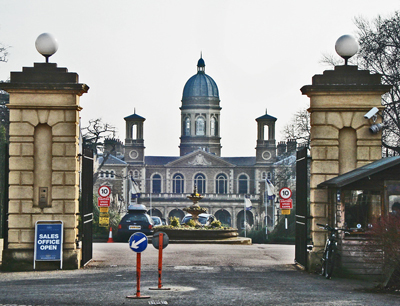
The historic front gates, kept open while the Hospital existed, are now kept firmly closed.
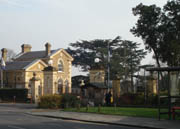
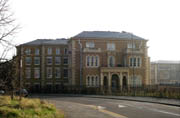

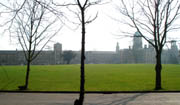
Princess Park Manor (above)
Friern Village (below)
The area looks suprisingly 'villagey', perhaps because of the almost complete absence of the motorcar.
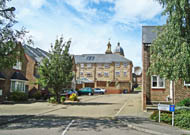
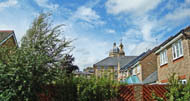
The towers of the former Friern Hospital can be seen from Highgrove Close and off Balmoral Avenue.
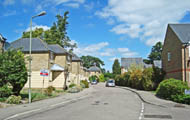
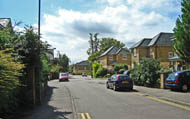
East along Balmoral Avenue (left) and west along Balmoral Avenue
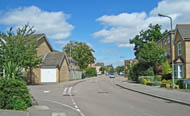

Ribblesdale Avenue (right) and Deepdale Close off Ribblesdale Avenue (right).
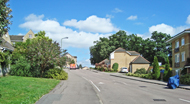
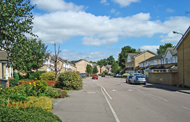
New housing along Ribblesdale Avenue.
Chaplin R, Peters S 2003 Executives have taken over the asylum: the fate of 71 psychiatric hospitals. Psychiatric Bulletin 27, 227-229.
Hunter R, Macalpine I 1974 Psychiatry for the Poor. 1851 Colney Hatch Asylum Friern Hospital 1973. A Medical and Social History. Folkstone, William Dawson & Sons.
http://pb.rcpsych.org
http://wapedia.mobi
www.barnet.gov.uk
www.british-history.ac.uk
www.enfield.gov.uk
www.countyasylums.com
www.memoriespictures.co.uk
www.sochealth.co.uk
Return to home page